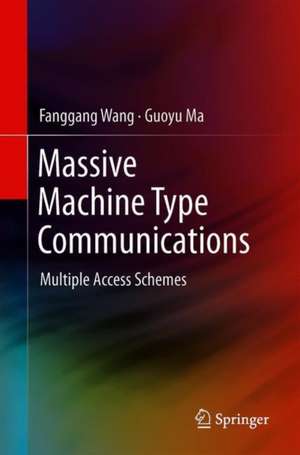Massive Machine Type Communications: Multiple Access Schemes: SpringerBriefs in Electrical and Computer Engineering
Autor Fanggang Wang, Guoyu Maen Limba Engleză Paperback – 2 apr 2019
With the thriving of Internet of Things (IoT) industry, an emerging scenario named massive machine-type communication (mMTC) is considered in the future 5G networks. One main challenge in mMTC is how to support massive connections with limited radio resources and low energy consumption. Therein, novel multiple access scheme is the key to overcome the challenge.
This SpringerBrief targets researchers and engineers, who are engaged in 5G and future IoT related communications system. It can also be a used as a reference book or a secondary text for graduate students, who major in communications.
Din seria SpringerBriefs in Electrical and Computer Engineering
- 19%
 Preț: 424.47 lei
Preț: 424.47 lei -
 Preț: 377.35 lei
Preț: 377.35 lei -
 Preț: 380.07 lei
Preț: 380.07 lei -
 Preț: 378.12 lei
Preț: 378.12 lei - 20%
 Preț: 379.08 lei
Preț: 379.08 lei -
 Preț: 377.18 lei
Preț: 377.18 lei - 20%
 Preț: 234.68 lei
Preț: 234.68 lei - 20%
 Preț: 232.43 lei
Preț: 232.43 lei -
 Preț: 378.12 lei
Preț: 378.12 lei -
 Preț: 377.18 lei
Preț: 377.18 lei - 20%
 Preț: 231.41 lei
Preț: 231.41 lei -
 Preț: 377.18 lei
Preț: 377.18 lei -
 Preț: 377.95 lei
Preț: 377.95 lei -
 Preț: 444.74 lei
Preț: 444.74 lei -
 Preț: 382.36 lei
Preț: 382.36 lei -
 Preț: 378.12 lei
Preț: 378.12 lei -
 Preț: 378.92 lei
Preț: 378.92 lei - 20%
 Preț: 232.43 lei
Preț: 232.43 lei -
 Preț: 376.80 lei
Preț: 376.80 lei -
 Preț: 377.35 lei
Preț: 377.35 lei -
 Preț: 377.18 lei
Preț: 377.18 lei -
 Preț: 381.00 lei
Preț: 381.00 lei -
 Preț: 376.43 lei
Preț: 376.43 lei -
 Preț: 377.18 lei
Preț: 377.18 lei -
 Preț: 378.54 lei
Preț: 378.54 lei - 20%
 Preț: 321.20 lei
Preț: 321.20 lei -
 Preț: 377.73 lei
Preț: 377.73 lei -
 Preț: 341.75 lei
Preț: 341.75 lei -
 Preț: 344.25 lei
Preț: 344.25 lei -
 Preț: 379.09 lei
Preț: 379.09 lei - 20%
 Preț: 324.64 lei
Preț: 324.64 lei -
 Preț: 377.57 lei
Preț: 377.57 lei -
 Preț: 378.71 lei
Preț: 378.71 lei - 20%
 Preț: 321.66 lei
Preț: 321.66 lei - 20%
 Preț: 230.85 lei
Preț: 230.85 lei -
 Preț: 374.30 lei
Preț: 374.30 lei -
 Preț: 375.45 lei
Preț: 375.45 lei -
 Preț: 360.05 lei
Preț: 360.05 lei -
 Preț: 381.43 lei
Preț: 381.43 lei -
 Preț: 378.34 lei
Preț: 378.34 lei -
 Preț: 376.22 lei
Preț: 376.22 lei - 20%
 Preț: 323.99 lei
Preț: 323.99 lei -
 Preț: 380.07 lei
Preț: 380.07 lei -
 Preț: 375.62 lei
Preț: 375.62 lei - 20%
 Preț: 321.20 lei
Preț: 321.20 lei -
 Preț: 377.18 lei
Preț: 377.18 lei - 5%
 Preț: 361.80 lei
Preț: 361.80 lei -
 Preț: 378.12 lei
Preț: 378.12 lei -
 Preț: 375.07 lei
Preț: 375.07 lei -
 Preț: 376.22 lei
Preț: 376.22 lei
Preț: 375.23 lei
Nou
Puncte Express: 563
Preț estimativ în valută:
71.81€ • 74.69$ • 59.28£
71.81€ • 74.69$ • 59.28£
Carte tipărită la comandă
Livrare economică 14-28 aprilie
Preluare comenzi: 021 569.72.76
Specificații
ISBN-13: 9783030135737
ISBN-10: 303013573X
Pagini: 78
Ilustrații: XIV, 56 p. 36 illus.
Dimensiuni: 155 x 235 mm
Greutate: 0.11 kg
Ediția:1st ed. 2019
Editura: Springer International Publishing
Colecția Springer
Seria SpringerBriefs in Electrical and Computer Engineering
Locul publicării:Cham, Switzerland
ISBN-10: 303013573X
Pagini: 78
Ilustrații: XIV, 56 p. 36 illus.
Dimensiuni: 155 x 235 mm
Greutate: 0.11 kg
Ediția:1st ed. 2019
Editura: Springer International Publishing
Colecția Springer
Seria SpringerBriefs in Electrical and Computer Engineering
Locul publicării:Cham, Switzerland
Cuprins
Chapter 1 Introduction 13.- Chapter 2 Random access procedure for mMTC 17.- Chapter 3 Compressive sensing based multi-user detection (CSMUD) 21.- Chapter 4 Coded slotted ALOHA (CSA) 29.- Chapter 5 Tandem spreading multiple access 35.- Chapter 6 Conclusion 65.
